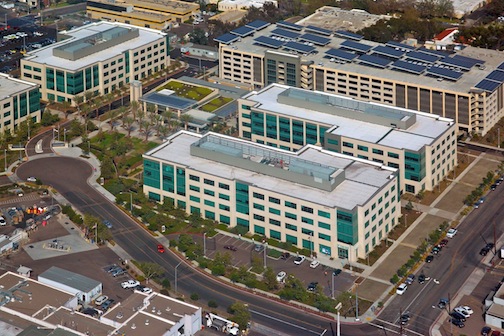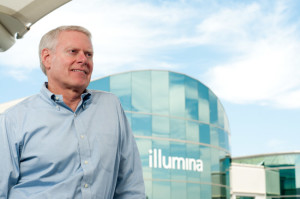San Diego Scene
An aerial view of the Space and Naval Warfare Systems Command (SPAWAR) Headquarters in San Diego.
SPAWAR
Space and Naval Warfare Systems Command
The Navy’s Big Economic Driver
The headquarters of the Space and Naval Warfare Systems Command in San Diego is noted for its massive World War II-era buildings with the sawtooth roofs that stretch between Pacific Highway and Interstate 5, just west of Lindberth Field. These are the same buildings where Convair routinely pushed B-24 bombers out the door during the war.
Most San Diegans probably have seen the elongated buildings but not many would know what goes on inside them. Officially, SPAWAR — as it is called — serves as the “Navy’s technical lead for command, control, communications, computers, intelligence surveillance and reconnaissance, providing the hardward and software to connect sailors at sea, on land and in the air.”
Basically, it is responsible for the information and communications networks connecting the Navy’s sea, land, air, and cyber defenses.
Today, the San Diego Military Advisory Council (SDMAC) is releasing its first economic impact study examining the impact of SPAWAR on the San Diego economy and job market.
Bottom line of the report: SPAWAR will pump more than $1.77 billion into the San Diego economy in fiscal 2014.

Commissioned and funded by SDMAC, the study was authored by Dr. Lynn Reaser, chief economist at Point Loma Nazarene University’s Fermanian Business & Economic Institute, and principal author of the study.
Some of the highlights of the study:
• SPAWAR will pump over $1.77 billion into the San Diego economy in Fiscal Year 2014. Funds will flow through five primary channels: SPAWAR employment and compensation, contracts to private firms, spending on operations and maintenance, smaller purchases made through government purchase cards, and associated tourism.
• SPAWAR will be responsible for nearly 19,000 jobs in San Diego County in Fiscal Year 2014 and $1.6 billion in total personal income (accounting for ripple and multiplier effects).
• SPAWAR will generate a total of $2.5 billion of output or GRP in Fiscal Year 2014. This amounts to nearly $800 for each San Diego County resident or approximately $2,200 for every household.
• SPAWAR directly employs more than 4,900 individuals in San Diego County, which puts it on a scale comparable to the 12 leading private sector employers in the region.
• SPAWAR employs a highly skilled, experienced, and educated work force, including over 160 PhDs and 1,200 master’s degrees.
• With an average civilian salary of $105,000, SPAWAR employees are compensated on par with their private sector counterparts possessing advanced skill sets.

“SDMAC’s study shows SPAWAR is a huge economic driver in the San Diego economy,” said Jamie Moraga, SDMAC president. “One half of SPAWAR’s nearly 10,000 employees work in San Diego; their cyber and information technology focus causes a vast ripple of highly technical and skilled jobs throughout the region.”
SPAWAR directly employs nearly half of all the cybersecurity jobs in San Diego and its presence in San Diego is a huge contributing factor for many cyber companies to remain located in San Diego, and its expansive research facilities and cutting-edge laboratories located in Point Loma are a unique National asset, according to the study.
“SPAWAR’s ripple effect on San Diego’s economy works both ways,” said Moraga. “Just as increased defense spending creates jobs, a cut in defense spending will reverberate through the local economy.”
What the Future Holds
Looking ahead to Fiscal Year 2015, the Department of Defense will be at the center of the conflict between national budget pressures and the critical need to upgrade the nation’s technology for defense, the study says. Even in the face of tremendous budget pressures and sequestration, the FY15 President’s Budget listed cyber security as one of the largest growth areas. On balance, dollars flowing into San Diego County linked to SPAWAR are expected to decrease 2.4 percent to $1.73 billion.
The study said SPAWAR/San Diego is now playing a vital role in upgrading the Navy’s entire fleet with new communications networks involving major advances in both software and hardware. The SPAWAR/San Diego nexus will be pivotal in supporting some of the Navy’s most important initiatives: developing unmanned undersea vehicles, expanding the Navy’s use of the electromagnetic spectrum, and continuing to develop the nation’s ability to dominate cyberspace.
*******************

$215 Million County Operations Center Now Complete
The recent completion of construction of the new Registrar of Voters building marked the final phase of the $215 million San Diego County Operations Center in Kearny Mesa.
The completion brings an end to the work done by Suffolk-Roel since 2009 to consolidate multiple county functions on a 30-acre site.
Besides the 118,000-square-foot Registrar’s building, previously completed facilities include four separate 150,000-square foot, four-story office buildings, a 30,000-square-foot conference center with a cafeteria and public auditorium, and a central plant with 3,600-ton cooling capacity; totaling 780,000 square feet of new space.
Because the project came under budget, the money saved allowed the county to add tenant improvements to existing buildings and various site improvements, county officials said.
All buildings have received Leadership in Energy and Environmental Design (LEED) certification from the U.S. Green Building Council, including the Platinum-certified conference center. The entire campus achieved LEED Gold certification.
The project team included the San Diego County Department of General Services, Lowe Enterprises, RJC Architects and Project Management Advisors Inc.
Suffolk-Roel is the result of Suffolk Construction’s 2011 acquisition of family-owned Roel Construction.

Bartell Hotels Completes $13 Million Expansion
Of its Holiday Inn San Diego Bayside Property
San Diego-based Bartell Hotels has completed a four-story, 44,000-square-foot, $13 million expansion of its Holiday Inn San Diego Bayside property at 4875 North Harbor Drive. The hotel expansion features a new entrance to the hotel consisting of a Mediterranean garden, a 23-foot sculpture and a 2,000-square-foot lobby with 18-foot ceilings. The expansion also added 57 guest rooms and suites with bay and marina views, a corporate boardroom and a 5,000-square-foot pre-function area and ballroom. The hotel now totals 291 guest rooms including 13 suites, and total meeting space of 9,750 square feet.

The large metal sculpture, Intersect, serves as an aesthetic focal point at the hotel’s entrance. It draws inspiration from marine and maritime life for which Point Loma and Shelter Island are famous, according to Bartell.
“The three delta shapes are representative of abstract seabirds, fish and sailboats as balance is reached when all of the elements are in harmony with each other,” said the sculpture’s creator, Matt Devine.
Joseph Wong of JWDA served as architect, Liz Bartell Design performed design work and Parterre Landscape Architecture handled landscaping.
The official Holiday Inn San Diego Bayside re-launch set for late winter 2014.
Board of Supervisors to Sue Caltrans for its
Approval of Jamul Casino Management Plan
The county Board of Supervisors has voted to take legal action against Caltrans over its approval of an encroachment permit and temporary management plan submitted by the Jamul Indian Tribe in connection with its proposed $360 million “Hollywood Casino Jamul” project. The tribe announced the start of construction activities for the casino, which it claimed would “blend seamlessly into the region.”
The transportation management plan and encroachment permit were submitted by the tribe to minimize any traffic impact on State Route 94 during construction of the casino.

Board of Supervisors Chairwoman Dianne Jacob, a resident of Jamul and longtime opponent of the casino project, issued a strongly worded statement against the tribe’s plans. “The tribe must take us for fools if it thinks a Hollywood-style, Costco-sized casino would blend seamlessly into rural Jamul,” said Jacob. “The giant gaming complex might generate profits for the tribe and its developer, but at the expense of the community’s quality of life.
“The tribe needs to follow the law and delay construction until an adequate environmental review of the traffic impacts has been completed. The county will be taking legal action to enforce the law.
Kearny Real Estate Co. Acquires Union Bank Building

Kearny Real Estate Co. has acquired the Union Bank building, a 232,098-square-foot office building at 530 B Street in Downtown San Diego, and will undertake a $15 million capital improvement program, the company announced. The sale price was not disclosed. Through a new long-term lease, Union Bank will continue to occupy a major portion of the building. While Union Bank will retain building top signage, Kearny will rebrand the building as 530 B.
The overhaul will include the building’s core plumbing, new restrooms, tenant improvements and a new indoor/outdoor patio that has been underutilized. “This patio is one of the reasons we bought this iconic building. It gives us the opportunity to create a wonderful indoor/outdoor experience for our tenants,” said Kearny partner John Bragg, who heads the firm’s San Diego office. “When completed in spring 2014 there will be nothing else like it for tenants in Downtown San Diego.”
Built in 1966 and renovated in 1992, the Union Bank Building had stood as the tallest building in San Diego for more than 20 years. Characterized by its floor-to-ceiling windows, every floor offers 360-degree views of the San Diego Bay, Pacific Ocean and Balboa Park.
TSA Contracting Elevates Ben Briggs and Kristen Freeman
Rancho Penasquitos resident Ben Briggs, a 25-year construction industry veteran, has been named project executive/senior project manager at TSA Contracting, a San Diego-based construction company. The company also announced the promotion of Kristen Freeman of San Diego to project manager. Briggs previously was project director where he performed project management and preconstruction services for a 116-unit apartment complex valued at $14 million. Freeman, a graduate of UC San Diego, previously held the title of project engineer at TSA. She will be responsible for projects in Los Angeles and San Diego counties

NBC and Bridgepoint Education Arranging to Leave Downtown
NBC is leaving Downtown. NBC has negotiated a termination of its lease and will be moving out of Downtown in October 2016, according to Jason Hughes, president and CEO of Hughes Marino, a San Diego commercial real estate company.
Comcast will be relocating the studio and office space to the suburbs into a company-owned building. “This will be a big loss to Downtown and to 225 Broadway where NBC has building top signage, their ground floor TV studios as well as the entire third floor, “ said Hughes.
Hughes also reports that Bridgepoint Education has negotiated a lease termination for its space at 600 B Street (floors 1 and 2), and will be leaving Downtown over the next six months. “Bridgepoint has building top signage as well, so that makes two great options for large companies wanting great identity in Downtown,” said Hughes. “For 600 B Street, this now provides for the entire lower half of the building as vacant — more than 160,000 square feet of contiguous space.”
The YMCA building at 500 West Broadway Downtown may soon go up for auction, following a failed run as a low-income hotel and other financial difficulties, according to Hughes.
Illumina’s New Low-Cost Genome Machine to Change Health Care Forever

In 2003, the cost of sequencing a human genome was $500 million. Thanks to San Diego’s Illumina, the cost today is down to $1,000. For years, modern science has been on a quest to affordably sequence the human genome.
Illumina, the world’s leading seller of gene sequencing machines, unveiled its HiSeq X (pronounced “High Seek 10”) recently. The system is the world’s first DNA-crunching supercomputer designed to process 20,000 genomes per year at a cost of $1,000 each. Although Illuminia may be the first to reach this hallmark, many other San Diego players, including Life Technologies and Craig Venter, have been involved in efforts to find an affordable way to sequence our DNA, proving some of the best scientific minds are right in our backyard.
Jay Flatley, Illumina’s chief executive officer, introduced the machine at an investors conference in San Francisco, saying customers will begin receiving the machine this quarter. “This will be a blockbuster product,” he said in an interview with Bloomberg Businessweek.
The high-speed, low-cost sequencing system arrives at a crucial time, with a number of biotech companies, research centers, and hospitals starting to show real clinical breakthroughs. “To figure out cancer, we need to sequence hundreds of thousands of cancer genomes, and this is the way to do it,” Flatley said.
Qualcomm Makes Worldwide Patent Top 10 List
Qualcomm has cracked the world’s top 10 list for the number of patents awarded in a year, KPBS reports. The San Diego-based company was one of only three American firms on the list. The wireless technology company landed in ninth spot in 2013 with 2,103 patents. That’s up sharply from the 1,292 patents Qualcomm added in 2012. That 62 percent gain also pushed it up from its 17 place ranking that year. Qualcomm joined IBM and Microsoft as the only U.S. companies among the top 10.
Qualcomm has more than 50,000 patents in its portfolio, according to Martin. The patents involve everything from how cell phones transmit and receive large amounts of data, to technology that allows for wireless links to smart devices in the home.
Biocom CEO Appointed to Independent Citizens Oversight Committee

Joseph Panetta, 59, of San Diego, has been appointed to the California Institute for Regenerative Medicine Independent Citizens’ Oversight Committee by Gov. Jerry Brown. Panetta has been president and chief executive officer at Biocom since 1999. He was global leader of government and regulatory affairs at Dow Agroscience from 1998 to 1999 and vice president of government and public affairs at Mycogen Corp. from 1988 to 1998. Panetta was a regulatory affairs manager at the Pennwalt Corp. from 1985 to 1988 and a senior policy analyst at the U.S. Environmental Protection Agency from 1979 to 1984. He earned a master’s degree from the University of Pittsburgh. The position does not require Senate confirmation and the compensation is $100 per diem. Panetta is a Republican.
Researchers Unlock the Key to Deadly Virus
Researchers at The Scripps Research Institute (TSRI), led by Professor Erica Ollmann Saphire, have now solved the structure of a key protein in the Nipah virus, an emerging pathogen found in Southeast Asia. Its initial outbreak in humans in 1997 has been followed by yearly outbreaks with increasing mortality rates. Lethality has increased from 40 percent initially to 70 percent and, in some cases, even 100 percent. There are no therapeutics for the virus and no vaccines for humans. This discovery could pave the way for the development of a much-needed antiviral drug.

The virus is carried by the flying fruit bat and causes only mild illness in pigs, dogs, cats, horses, goats and sheep, which also spread the disease. “It’s the scariest virus you’ve never heard of,” said Jessica Bruhn, a graduate student in Saphire’s lab, noting that the movie “Contagion, “ a medical thriller that came out in 2011, is based on outbreaks of the Nipah virus. Bruhn initially designed this study of Nipah as a summer internship project in 2012 for Katherine Barnett, then an undergraduate student in a summer program at TSRI, who is also a co-author of the paper.
Cubic Wins $18.3 Million Contract
For F-35 Air Combat Training System

Cubic Defense Systems, a subsidiary of Cubic Corp., has been awarded an $18.3 million contract from Lockheed Martin Aeronautics to design and integrate its latest-generation air combat training system for the F-35 Lightning II, also known as the Joint Strike Fighter. Cubic is scheduled to deliver airborne instrumentation and ground station planning and debrief software systems as part of F-35 System Development. Cubic’s air combat training system will be deployed to several countries receiving the F-35 jets including the United States, United Kingdom, Italy, Australia and Norway.
“The F-35 Training Subsystem will be embedded and integrated in the aircraft as they roll off Lockheed Martin’s production line,” said Dave Schmitz, president of Cubic Defense Systems.
Cubic and its principal subcontractor, DRS Technologies Inc., will use an embedded P5 solution as the baseline for the F-35 Internal Training Subsystem. Engineering work for the training systems will be performed in San Diego. The contract is the first delivery of production units that will be deployed with the Block 3 F-35 stealth fighters.
From left: Nico Ferraro, Stephen Cushman and Laurie Coskey
Convention Center Corporation Board Gets New Leadership
Nico Ferraro, a 19-year veteran of the Plumbers and Pipefitters Union, is the new chair the San Diego Convention Center Corp.’s board of directors. Businessman Stephen Cushman was elected vice chairman of the board, and Rabbi Laurie Coskey was elected secretary-treasurer. Ferraro worked in the pipe trades industry for 40 years. His union career ended with his retirement in 2008. Gov. Gray Davis appointed him to the Industrial Welfare Commission Wage Board. Cushman, who has been actively involved with numerous boards and commissions, established The Cush Automotive Group and was a recognized leader in the automotive sales industry before its sale in 2006. Coskey is the executive director of the Interfaith Committee for Worker Justice, an organization representing clergy, churches, mosques, synagogues, faith and justice organizations in San Diego.



